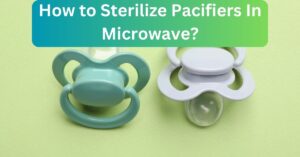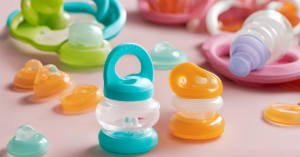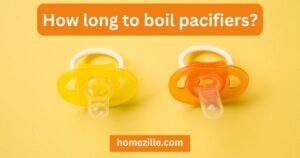Isn’t it exciting to be a new parent? You always think about that tiny creature. You are always concerned about your baby. But the biggest worry is washing baby items.
Imagine your baby cries at 3 a.m. in the morning because of hunger. And you wake up realizing that all the milk bottles and pacifiers are piled up in the kitchen sink. Now, you have to wash these items at midnight. Scary it is! I know right.
New parents often forget to wash their baby’s bottles and pacifiers regularly. If you want to avoid such a situation at night, don’t forget to cleanse the baby items before you sleep.
One of your primary concerns as a new parent is ensuring the safety and well-being of your child. In addition to washing your hands and cleaning surfaces like tables, countertops, and doorknobs, it is important to wash and sterilize baby items like pacifiers, bottles, and toys.
The most important thing is to ensure that your baby doesn’t get sick, so make sure that everything he or she eats or drinks is thoroughly clean. Also, making sure your baby’s bottles and pacifiers are clean will help stop germs and bacteria from making your child sick.
As far as sterilizing the pacifiers and milk bottles is concerned, there is no particular requirement that you purchase a sterilizer for baby bottles. Sterilize bottles and pacifiers before the first time you use them. Always clean the bottles and pacifiers every time your baby feeds. But there is no need to sterilize bottles after each feed.
Now the main question is “how to sterilize pacifiers and baby bottles.” In this post, I will discuss different methods of sterilization. Keep reading the article!
Do You Need to Sterilize Pacifiers and Bottles After Every Use?
If you plan to use bottles or pacifiers, you should sterilise them before you use them for the first time and then on a frequent basis after that. However, it is not required to sterilise them immediately after each use as long as you do it on a regular basis. When it comes to pacifiers, bottles, and bottle nipples, how often do you clean them after the initial cleaning?
Despite the daily cleaning, these items should be sterilized regularly. Sterilization should be done on a regular basis, whether that’s once a week, twice a month, or at least once a month; the key is to find a routine that works for you and that you can follow conveniently.
These measures are necessary to prevent diseases from spreading. It is a good idea to sterilise your baby’s bottles and pacifiers if they have been used by another infant after your child has been unwell, you or other members of your family have had an infectious disease, or if another infant has used the milk bottle that your baby uses. Your child’s cleaning and sanitizing habits are entirely within your control as a parent.
When Should You Sterilize Pacifiers and Bottles?
Not every time you give your baby his favorite pacifier or bottle, you’ll have to boil it or sterilize it. Both of them are pointless. Only a quick rinse is needed for cleaning bottles. In some cases, however, a thorough sterilization process is required.
As recommended by the Centers for Disease Control and Prevention, you should sterilize bottles before giving them to babies who were born early or have weak immune systems. Some pediatrics also say that babies of about three months of age should have their bottles sterilized.
Note: If you’ve been sanitizing your baby’s bottles and pacifiers on a regular basis, you can stop at around three months of age. When you are in doubt, consult your child’s doctor.
The first time you use a bottle or pacifier for your baby, you should sterilize it to make sure it is completely clean and germ-free.
TIP: If your baby had some viral infection, it is recommended to sterilize your baby’s bottles and pacifiers.
You should also keep an eye on your baby’s pacifiers and bottles, and stop using them if their authenticity has been compromised by regular cleaning.
How to Sterilize Pacifiers and Bottles?
After each feeding, regardless of whether or not you sanitize the baby’s bottles, still you must thoroughly clean them. Babies and newborns are likely to be infected by numerous disease-causing germs because their immune systems are still developing.
For example, a temporarily used bottle that hasn’t been thoroughly cleaned can quickly become a breeding .The great majority of potentially harmful germs found on bottles can be eradicated with a simple wash in hot soapy water.
WHAT ARE THE DIFFERENT METHODS OF STERILIZATION?
Boil bottles and pacifiers
Boiling is the simplest method of sterilizing bottles and pacifiers.
Here is how you sterilize them by boiling method.
⦁ To begin, wash pacifiers and bottles with dish soap and water.
⦁ All the pacifiers and bottles should be placed in a clean saucepan or a pot.
⦁ Pour the water over everything. Bottles and pacifiers should be completely submerged in water.
⦁ Turn on the stove on high heat and boil water on it.
⦁ Dip the milk bottles in boiling hot water for about 5 to 7 minutes.
⦁ Carefully remove them from hot water. You can use clean tongs or wear hand gloves.
⦁ In order to dry your bottles, simply turn them upside down and place them on a rack.
Using a microwave sterilizer
A microwave-operated bottle steam sterilizer is an excellent choice for washing pacifiers and bottles quickly and affordably. It completely sterilizes the bottle by completely sealing it off and using steam.
Below are the step-by-step instructions on how to sterilize baby products using microwave steam.
⦁ Make sure the water level in the bottles is at least halfway up.
⦁ For this step, you must use a freshly sanitized microwave (this is very important, you cannot skip this step!).
⦁ Turn ON the microwave oven for 1.5 minute.
⦁ Place the bottles in the microwave for one minute.
⦁ Take them out of the pan (they’ll be hot, so use caution)
⦁ Drain the pan of any remaining water, and pat them dry.
Precaution: To prevent the danger of pressure buildup in closed bottles, you should disassemble the bottles before sterilization begins to prevent this risk.
Cleaning baby bottles by hand:
Washing bottles and their pieces by hand can lead to cross-contamination, so the Centers for Disease Control and Prevention (CDC) recommends using a separate container for bottles only.
Additionally, a bottle brush or other specialized cleaning tool for baby bottles is also a smart investment.
⦁ Wash your hands first properly.
⦁ Rinsing the bottles and components in cool water is all that is needed to remove any remaining milk.
Note: Never place your bottles in the sink.
⦁ Fill a clean tub with hot water and a liquid soap.
⦁ Use a bottle brush for cleaning pacifiers and bottles properly.
⦁ You should also wipe water through the nipples’ tiny holes while cleaning.
⦁ Remove the soap foam by rinsing under running water again.
⦁ Remove any remaining water with a dry dishcloth.
⦁ Store the pacifiers and bottles when they have dried up.
Using electric steam sterilizer
An electric steam sanitizer is a wise investment if you plan to clean bottles on a daily basis. Put the bottles in, and read the instructions written on the package of sterilizer.
The steam formed by this electric steam sterilizer is much hotter than the steam generated by boiling water. It takes only minutes for the vast majority of steam sterilizers to complete an entire cycle.
Using the dishwasher:
How to sterilize your bottles by hand if you do not have enough time? You can sterilize them in the dishwasher. If you still doubt whether your baby’s milk bottles are dishwasher-safe or not, check the company’s guidelines. Most bottles can be sanitized by running them through the hottest possible washing and drying cycles.
⦁ To keep them clean, run them through a normal cycle in the dishwasher (check the product packaging to make sure the items can be cleaned in the dishwasher!).
⦁ In order to prevent milk bottles from melting, place the milk bottles on the topmost rack of the dishwasher.
⦁ Placing small parts like pacifiers in a special basket on top of the dishwasher’s rack will protect them from melting. Because in the lower racks of the dishwasher, the temperature is too high for these baby products.
⦁ Ensure that the bottles and pacifiers are totally dry before storing them.
Sterilize with a bleach solution:
Even though it’s a common misconception, you can clean baby bottles and pacifiers with just cold water and a special sanitizing tablet or solution.
In the United States, the Centers for Disease Control and Prevention (CDC) is a part of the Department of Health and Human Services’ (DHHS). Also known as the Centers for Disease Control and Prevention) suggests using 2 teaspoons of unscented bleach mixed with 1 gallon of water for at least two minutes to clean items that can’t be steam cleaned (as opposed to the above-mentioned preferable methods).
After rinsing them with lukewarm water, allow the products to dry in the air.
When to Stop Sterilizing Baby Bottles Frequently?
According to CDC (Centers for Disease Control and Prevention) recommendations, you can stop sterilizing baby bottles after three months of age because the newborn’s immune system is no longer as sensitive.
Dr. Daniel (pediatrician at Providence St. John’s Health Center) says that once you notice any damage, you should stop sterilizing baby bottles daily. Also there is no use keeping plastic bottles that have splits, cracks and strong odors, as well as glass bottles that have chips or cracks. Small children are at risk of choking if their bottle nipples are worn down and need to be replaced immediately.
Tips:
⦁ Make sure you wash your hands before handling baby bottles and pacifiers.
⦁ Immediately after using the nipples and bottles, rinse them with water to make them easier to clean.
⦁ Make sure the water bottles in the pan don’t have any air bubbles because that could cause them to break.
Warnings:
⦁ Before being used for the first time, baby bottles, nipples, nipple caps and rings, and pacifiers all need to be sterilized.
⦁ This is the case even if the original packaging has not been compromised in any way.
FAQs
What is the safest way to sterilize baby bottles?
Using an empty, clean tub, mix 2 tablespoons of bleach per gallon (16 cups) of water. All items should be submerged to the bottom of water in the pot. Ensure that the solution is evenly distributed throughout and that the bottles are free of air bubbles. Let them remain submerged in the mixture for fifteen minutes. After that, rinse the bottles thoroughly and air-dry them before storing.
Do I need to sterilize bottles every time?
Most moms wonder when you don’t sterilize baby bottles, what could be the consequences?
Well! bacteria can grow on your baby’s feeding products, bottles, nipples and pacifiers. If you don’t properly sterilize the bottles infections can result in diarrhea. If you have a newborn baby or he/she is younger than 3 months, you have to sterilize the feeding items daily.
Is boiling baby bottles safe?
Using hot water to sterilize baby bottles is an effective method.
You will only need a pot and some boiling water to sterilise infant bottles. And don’t worry, you can use this approach to sanitize plastic bottles. The plastic won’t melt. However, ensure that you do not boil the bottles for too long. Approximately five to seven minutes are more than enough for sterilizing milk bottles in boiling water.
Where do you store baby bottles after sterilizing?
After each feeding, sterilise and sanitize bottle-feeding utensils. To begin, wash all of the equipment with hot, soapy water. Next, sterilise by boiling, using bleach solution, steaming, or microwaving the food item. Finally, store the disinfected and sanitised equipment in the refrigerator. You can also place the pacifiers in an air-tight ziploc bag.
Is it OK to use dish soap to clean baby bottles?
Baby bottles may be washed with dish soap without the need for a dishwasher. Add Natural Dish Soap to hot water in a small wash basin to create a thick froth. Rinse each component separately (e.g. nipples, caps, rings) with fresh water before putting them back together. Dry the bottles and store them in a ZIPLOC bag inside a cabinet.




